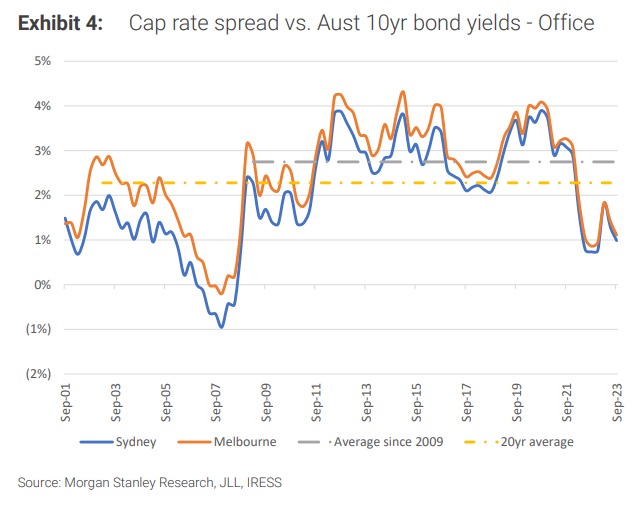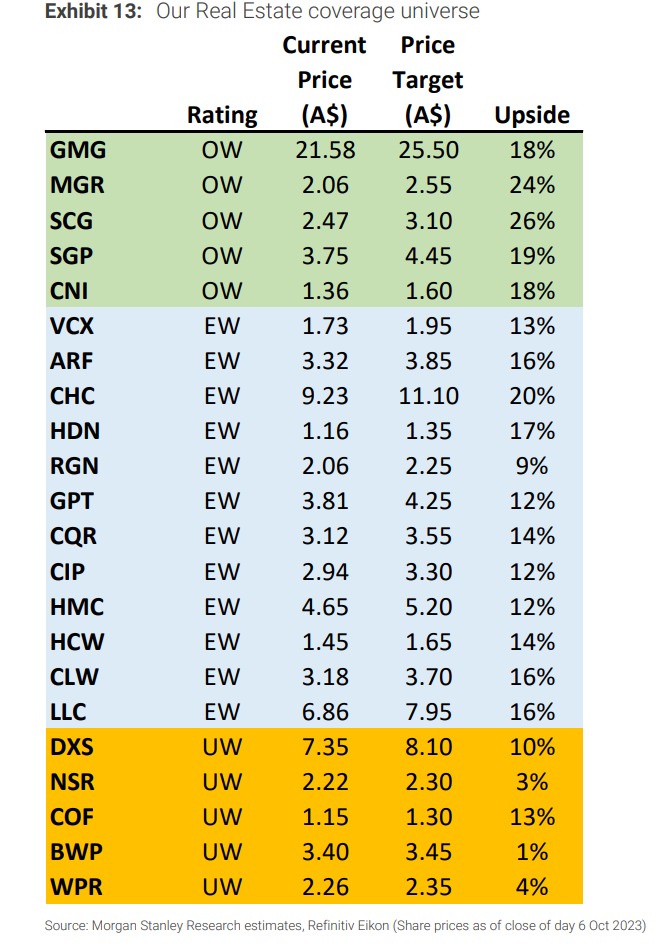Thinking REITs look cheap right now? Not so fast...
Real estate investing offers two choices - buy the property or buy the stock in an entity owning multiple properties. Listed REITs have been a feature of the ASX since 1971 when General Property Trust listed on the ASX.
A new note from Morgan Stanley analysts Simon Chan and Lauren Berry considers REITs as an asset class.
“Excluding the five fund managers (Goodman Group (ASX: GMG), Charter Hall Group (ASX: CHC), Centuria Capital (ASX: CNI), HCM Capital (ASX: HMC), and Lend Lease (ASX: LLC)) in our coverage, our coverage universe is trading at an average 23% discount (P/NTA 0.77x)."
As to the factors driving this change, Chan and Berry do not think that fundamentals are at play
We think this is macro rather than fundamentals driven. If cap rates [capitalisation rates, calculated by dividing a property's net operating income by its current market value] were to reflect the Aust 10-year bond yield trajectory, most stocks would be trading in line with adjusted-NTAs.”
Macro factors and recalibrating the risk assumptions
The macro factors of interest to the team are the risk free rate, equity beat and cap rate.
In terms of the risk free rate, they’ve adopted a 5% risk-free rate across all Bear Cases (previously 4% across Bull/Base/Bear). They’ve also updated their equity beta to reflect the past five years.
The final factor is cap rate assumptions. The analyst team’s cap rate assumptions reflect historical spreads , with the team not making any adjustments to fundamental factors such as rent growth, and therefore EPS/FFO.
When comparing the cap rate spread to the yield from Australian 10-year bonds, the analysts have considered three different segments - office, industrial and logistics.
Taking office as an example, the chart below shows the trend.

Chan and Berry note the consequences
“At current book values, the spread between each REIT's cap rate, and the Aust 10yr bond yield, is much tighter now than the typical spread over the last 15-20 years.
Assuming bond yields stay where they are and spreads revert to the long-term average, we think there is a material 17-33% downside to asset valuations across our coverage.”
They caution that their analysis holds other factors constant and these factors such as WALE, location, capex requirement, and rent outlook also impact valuation.
Applying the analysis to a group of 12 stocks -
- Dexus (ASX: DXS)
- Mirvac Group (ASX: MGR)
- GPT (ASX: GPT)
- Stockland Group (ASX: SGP)
- Scentre (ASX: SCG)
- Vicinity (ASX: VCX)
- Region Re (ASX: RGN)
- Charter Hall Long WALE REIT (ASX: CLW)
- Charter Hall Retail REIT (ASX: CQR)
- Centuria Office REIT (ASX: COF)
- Centuria Industrial REIT (ASX: CIP) and
- HomeCo Daily Needs REIT (ASX: HDN)
they note
“Looking at the historical average, we see that the REITs have traded at around 1x P/NTA. The lowest is VCX at 0.9x, whilst the highest is SGP at 1.06x. Either way, things round to 1x P/NTA"
They explain further:
“For a lot of our stocks, especially the larger REITs in the ASX100, it is clear that whilst their current share prices imply a discount to published NTA, they are actually broadly in line with our adjusted NTA if cap rates were to be above the 10yr bond yield by an historical average spread”
Impact on price targets and weightings
Morgan Stanley has revised its price targets across its coverage of the REIT sector as set out in the chart below.

In terms of its ratings for the 12 REITs noted earlier, it has
GPT, Vicinity, Region Re, Charter Hall Long WALE, Charter Hall Retail REIT, Centuria Industrial REIT and HomeCo Daily Needs REIT rated at EQUAL WEIGHT
Dexus and Centuria Office rated at UNDERWEIGHT
Mirvac, Stockland and Scentre rated as OVERWEIGHT.